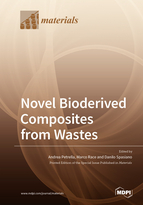Novel Bioderived Composites from Wastes
A special issue of Materials (ISSN 1996-1944). This special issue belongs to the section "Advanced Composites".
Deadline for manuscript submissions: closed (30 April 2020) | Viewed by 36891
Special Issue Editors
Interests: material recycling; inorganic compounds; wastewater treatment; photocatalytic materials; biopersistent pollutants; nanocomposites
Special Issues, Collections and Topics in MDPI journals
Interests: soil remediation; contaminants of emerging concern (CEC); wastewater treatment; soil management; hazardous waste
Special Issues, Collections and Topics in MDPI journals
Interests: nanomaterials; wastewater treatment; adsorption; solid waste management; soil remediation; photodegradation; degradation; wastewater reuse
Special Issues, Collections and Topics in MDPI journals
Special Issue Information
Dear Colleagues,
The recovery of solid wastes for the preparation of innovative composite materials not only represents an economic advantage, but also offers an ecological opportunity for the utilization of by-products which would otherwise be landfilled. Specifically, the reuse and recycling of waste leads to important savings of raw materials and energy, since these by-products, generally deriving from agricultural or industrial activities, are abundant in nature. Moreover, a reduction of the environmental and related sanitary impacts can be also achieved.
For this reason, a recycling operation is fundamental for the improvement of the environmental sustainability because these secondary raw materials become a resource that can be easily reused without modification of the peculiar characteristics in order to obtain new and performing composites with a low specific weight, high durability, and long life cycle. To this end, it is my pleasure to invite you to submit a manuscript for this Special Issue. Full papers, communications, and reviews are all welcome.
Prof. Andrea Petrella
Prof. Marco Race
Prof. Danilo Spasiano
Guest Editors
Manuscript Submission Information
Manuscripts should be submitted online at www.mdpi.com by registering and logging in to this website. Once you are registered, click here to go to the submission form. Manuscripts can be submitted until the deadline. All submissions that pass pre-check are peer-reviewed. Accepted papers will be published continuously in the journal (as soon as accepted) and will be listed together on the special issue website. Research articles, review articles as well as short communications are invited. For planned papers, a title and short abstract (about 100 words) can be sent to the Editorial Office for announcement on this website.
Submitted manuscripts should not have been published previously, nor be under consideration for publication elsewhere (except conference proceedings papers). All manuscripts are thoroughly refereed through a single-blind peer-review process. A guide for authors and other relevant information for submission of manuscripts is available on the Instructions for Authors page. Materials is an international peer-reviewed open access semimonthly journal published by MDPI.
Please visit the Instructions for Authors page before submitting a manuscript. The Article Processing Charge (APC) for publication in this open access journal is 2600 CHF (Swiss Francs). Submitted papers should be well formatted and use good English. Authors may use MDPI's English editing service prior to publication or during author revisions.









